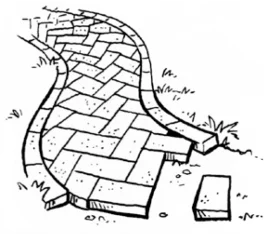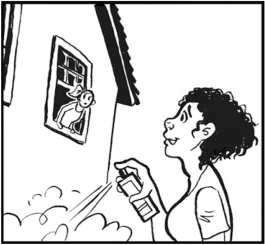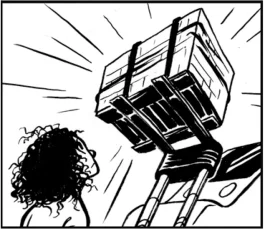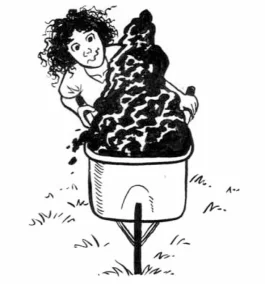
Imagine a backyard full of blueberry bushes, plum trees, wild grass, and a profusion of flowers, with a curving brick walkway that carries you along a path half hidden from view. You arrive at a bench under a mature crepe myrtle, and then sit in its shade, book in hand, pink blossoms at your feet, and the scent of jasmine in the air.
That’s what I imagined after we’d settled into our new home. True, I was looking out over a barren backyard, dotted with the few remnants of weeds and scrub bushes that our dogs hadn’t yet destroyed. Undaunted, I decided to bring my dreams to life, beginning with the walkway.

In the process, I learned everything there is to know about building such a path. If you come on the step-by-step journey with me, you, too, can create a garden wonder. Simply begin as follows:
1. Have an argument with Husband about the placement of the walkway. You want one with gentle curves that can be accented with plantings. He wants a direct path that will get him straight to his shed. He agrees to your plan if you’re willing to do the work. This seems like a good idea at the time.
2. Go to the masonry store to choose from among dozens of brick pavers. Bring a sample brick from your patio so you can confirm that nothing in the storeroom will match.

3. Lay down newspaper in the shape and direction you want the walk to take, then use whatever leftover spray paint you have in the basement to mark the grass edges, imagining this to be Martha Stewart style. Now you know where to dig. Note that the neighbors are looking from their second-story windows at your newspaper walk trimmed with silver and blue paint and concluding that it’s time to move. (Or, rather, for you to move.)
4. Start digging with a spade. Realize after two tiring feet of toil that you have forty-eight to go.
5. Look at the piles you’ve created after removing the grass, the middle layer of topsoil, and the bottom layer of clay. Conclude that these piles will soon turn into mountains if you don’t develop a strategy.
6. Ask Husband for advice. He helpfully suggests making several much-needed garden beds out of the half-hidden rock from around the yard. He notes that all you’ll need to do is move the topsoil after assembling the rocks. He returns to his sandwich.
7. Spend several hours excavating stones with a rock bar and moving them across the yard. These will need to be individually selected and chiseled so they interlock, creating a stable foot-high border that can hold the soil in place. This is called stonework, and usually you pay people with experience and tools to do this type of thing. Or do what normal people do and go to Lowe’s and buy premade stacking borders.

8. Take time to admire what you have accomplished so far. You have now cleared five feet of walkway. Several large mounds of discarded grass and clay litter the yard. The dogs have been practicing their digging skills by expand-ing the holes where the rocks once rested peacefully. You now have the beginnings of a garden bed large enough for two tomato plants and some basil. And a path that isn’t.
9. Watch the truck arrive prematurely to deliver the brick and sand. It takes a special forklift to move the heavy loads to your front lawn, where they are crushing the only grass you have left. Think hard about taking a nap.

10. Observe that, on Project Day Three, the first garden bed is finally ready for the soil. Clear ten more feet of walkway, sorting the material as you dig into new piles: topsoil for the beds, grass clumps for the compost, clay for the holes, and silver painted scrub for the trash. You’ve made excellent progress. Don’t look at the untouched sand and massive brick cube on your way to the car.
11. On Day Four you should continue throwing the soggy tennis ball to your OCD dog every ten seconds while you work (you have, of course, been doing this on Days One, Two, and Three), because otherwise she’ll lay a guilt trip on you. Try to ignore the other dog, who’s been napping on top of your piles, then tracking the soil back into the house through the dog door when the mood strikes. Stop thinking about the moral aspects of euthanizing animals in their prime.
12. Recall that it’s Saturday, the day of the Farmer’s Market. They are selling lots of heirloom plants. It would be nice to have something to put in those new garden beds. Spend some time shopping for plants instead of digging.

13. Speculate that these plants will need something better than that old topsoil. You’d best find your digging shovel and get some of that lovely compost you’ve been nursing since last fall. Coax it through the bottom door of the composting barrel. As sweat drips into your new wheelbarrow, don’t think about returning to your nice, comfortable house.
14. After planting, watering, and admiring the first new bed, measure out the next ten feet of walk, which accomplishes nothing but is easy to do. Notice that your right shoulder isn’t working quite the way it used to.
15. Observe that you’ve spent two more days of heavy digging, and you’re almost done removing the soil—only eight feet left. Don’t think about the plantar fasciitis irritated by the spade work that is causing constant pain to the bottom of your right foot. It will go away if you stop standing or walking for a few weeks.
16. Shovel sand into the wheelbarrow, then after you’ve dumped a couple of loads onto the pathway, screed it with a scrap 2-by-4. Curse the dog as he lies down in your carefully leveled sand. And then, after rescreeding, does it again.
17. Get a couple dozen bricks from the front yard (from the cube of five hundred) and begin laying the herringbone pattern that will curve from the house to the shed. After discovering that your tile saw won’t cut this brick, realize that you’ll need to rent a paver saw to make all those angled cuts on the edges. Get on the Internet to check prices. This is a good time to play some Spider Solitaire.
18. Curse the day you chose a lovely herringbone with a curve rather than the straight walk with an easy running pattern and no cuts that Husband suggested.

19. Count up all the calories you burned this week, just for the hell of it. Reflect on the shortness of life. Don’t wonder what the neighbors are thinking about the four hundred and eighty-eight bricks and one-ton pile of sand still on the front lawn.
20. Go take that nap. ❖
Postscript: Gayla did complete her walkway, garden beds, and related backyard projects in three weeks—without lasting injury to her body or relationships.


 Previous
Previous

